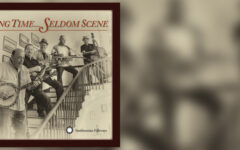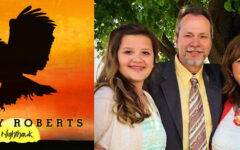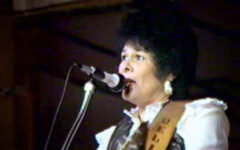
For those of you who might be in a hurry, here’s the abridged version right up front: Pretty Good For A Girl, Murphy Hicks Henry’s epic history of women in bluegrass music, is a magnificent and important work, and if you have any interest in the history and evolution of bluegrass, you should go buy a copy right away.
But there’s so much more to tell you! Like practically everybody who knows about Murphy and her project, I have been eagerly waiting for this book for a long time. With Pretty Good For A Girl, Murphy has done a lovely thing for any woman who ever wanted to pick and sing. And though it will resonate with female musicians, it’s definitely not for women only. The book is a delight to read, engaging and entertaining. It’s quirky and unpredictable and passionate and occasionally outrageous. And all of the women included here provide mesmerizing material with the details of their lives as bluegrass musicians. I was deeply moved by some of their stories, and I feel richer for knowing more about them.
Who ARE the women of bluegrass music? Early in the book, Murphy explains her rules for inclusion in Pretty Good For A Girl: they must be female musicians from bands that feature the five-string banjo played Scruggs-style. Then she cheerfully breaks those rules, devoting chapters to Laurie Lewis (who has recorded and performed with cello, piano, trombone, saxophone, and drums, and nary a banjo in sight); Missy Raines (whose New Hip ensemble features drums and bass and no five-string); and Cherryholmes (the disbanded family group whose matriarch, Sandy, has apparently retired from music, and whose youngest daughter, Molly Kate, is now following her own wild muse into interesting but decidedly non-bluegrass territory).
The book is separated into chapters by decade, starting with Sally Ann Forrester, Wilma Lee Cooper, Rose Maddox, and Ola Belle Campbell Reed in the 1940s. The 1950s chapter includes, among others, the stories of Bessie Lee Mauldin, Grace French, the Lewis Family women, the women of The Stonemans, and Margie Sullivan. The chapter on the 1960s includes the stories of Jeanie West, Gloria Belle, Hazel & Alice, Vivian Williams, Ginger Boatwright, the Whites, Wendy Thatcher, Martha Adcock, the McLains, and more; the ’70s chapter features Suzanne Thomas, Delia Bell, the Buffalo Gals, Lynn Morris, Kathy Kallick, Claire Lynch, and others.
The chapters for bluegrass women of the ’80s and ’90s are quite short: Leaders of the Band (the ’80s) includes only Missy Raines, Alison Brown, Alison Krauss, and a collective “All Female Bands.” The final chapter is called Too Many to Count: The 1990s and Beyond, and covers Kristin Scott Benson, Rhonda Vincent, the Dixie Chicks, and the ladies of Cherryholmes.
With a gentle hand, Murphy explores some fairly challenging themes. Ingrid Herman Reese’s confessions about the conflict of motherhood and work, for example, are candid and heartbreaking. “If I tell you I was a rotten mother,” Reese says, “it stops you from saying it to me.” When Rubye Davis of the Season Travelers talks about living in the shadow of her husband Hubert – even though she was the band’s lead singer and guitar player – her words are wistful and sad, almost bitter. And Alison Brown offers some startling (but perhaps not surprising) revelations about Bill Monroe: in addition to being the Father of Bluegrass, he was apparently also its original “old road dog.” (I frankly doubt that this will surprise any woman who has spent enough time in the bluegrass community, which probably has enough old road dogs to fill a pound.)
There are three photo sections in Pretty Good For A Girl, and the satisfying collection includes some gems: Betty Buckland playing banjo as Sonny Osborne looks on admiringly… Hazel Dickens pretending to mow the lawn… a great old shot of Buck White and the Down Home Folks from the early days, when the late, lovely Patty White was still singing with the band… the women of the Together Tour (Sally Van Meter, Laurie Lewis, Lynn Morris, Kathy Kallick, and Markie Sanders) on an airplane bound for Japan in 1997… the Buffalo Gals in a tree with their instruments… even a shot of Murphy’s own band with her talented siblings, the Hicks Sisters.
Murphy’s own musings are often very insightful and thought-provoking. She makes it a point to mention the extraordinary (and perhaps underrated) bass playing of Ruth McLain. I remember wondering, as a very young bluegrass-raised kid, why more upright bass players didn’t play like Ruthie. After a few years of watching local bassists attempt that rollicking, dynamic, doghouse-slappin’ style, I realized that most of them probably weren’t up to the challenge.
Yep, Ruthie was pretty darn good… for a girl.
Not surprisingly for a project of this scope, a few areas might have benefited from an extra bit of editorial attention. There were some name misspellings that unfortunately appeared in both the uncorrected proof of the book and in the final published version. Murphy even spelled my name wrong a couple times.
But she also got it right a couple of times! And that sort of mirrors the way I feel about this book: the few little things Murphy got wrong don’t matter so much, because the things she got right are so very, very right.
I am a proud, unabashed fan of Pretty Good For A Girl, and I hope there are many reprintings; I think it should be included in bluegrass curricula wherever they are taught. Murphy’s long-awaited magnum opus contains many important conversations with and about women who made names for themselves as bluegrass musicians. This incredibly significant publication is filled with engaging, intriguing stories of the women who helped plant and sow the seeds of bluegrass music, simultaneously juggling the challenges of career, motherhood, marriages and relationships, touring, band dynamics (and often management, agenting, advancing, stage attire design and tailoring, marketing and publicity), and much more. Murphy asks many important questions, covers tremendously important ground, and does it all in an interesting and friendly book that I know I will read again and again, learning something new every time.
Don’t miss Pretty Good For A Girl. It is one of the most important bluegrass books that will be published this decade.
Pretty Good For A Girl by Murphy Hicks Henry; June 2013; 528 pages; 66 b/w photographs; published by University of Illinois Press, www.press.uillinois.edu, $90/clothbound; $29.95 paperbound.







